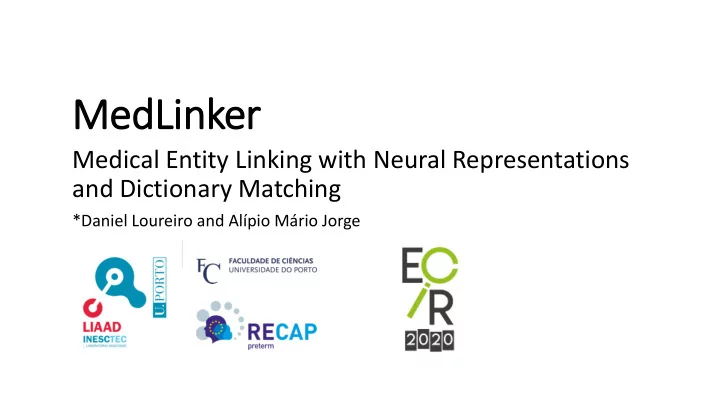

MedLinker Medical Entity Linking with Neural Representations and Dictionary Matching *Daniel Loureiro and Alípio Mário Jorge
Medical Entity Linking • Medical literature is growing rapidly. • This information is extremely important, but also hard to parse. • Current SOTA of NLP can help with Entity Linking. • Prior methods, such as dictionary matching, are still relevant. We’ll show how SOTA NLP can benefit from dictionary matching, in this important task. Introduction Span Recognition Contextual Matching Dictionary Matching Entity Linking Results Conclusion
Defi fining Task The flexion - relaxation phenomenon (FRP) in standing is a specific and sensitive diagnostic tool for low back pain. Seated flexion as an alternative could be beneficial for certain populations, yet the behavior of the trunk extensors during seated maximum flexion compared to standing flexion remains unclear. Compare FRP occurrences and spine angles between seated and standing flexion postures in three levels of the erector spinae muscles. Introduction Span Recognition Contextual Matching Dictionary Matching Entity Linking Results Conclusion
Defi fining Task The flexion - relaxation phenomenon (FRP) in standing is a specific and sensitive diagnostic tool for low back pain. Seated flexion as an alternative could be beneficial for certain populations, yet the behavior of the trunk extensors during seated maximum flexion compared to standing flexion remains unclear. Compare FRP occurrences and spine angles between seated and standing flexion postures in three levels of the erector spinae muscles. Introduction Span Recognition Contextual Matching Dictionary Matching Entity Linking Results Conclusion
Defi fining Task low back pain UMLS:C0026845 T017 The flexion - relaxation phenomenon (FRP) in standing is a specific and sensitive diagnostic tool for low back pain. Seated flexion as an alternative could be beneficial for certain populations, yet the behavior of the trunk extensors during seated maximum flexion compared to standing flexion remains unclear. Compare FRP occurrences and spine angles between seated and standing flexion postures in three levels of the erector spinae muscles. muscle UMLS:C0026845 erector spinae muscle group T017 UMLS:C0224301 T017 Introduction Span Recognition Contextual Matching Dictionary Matching Entity Linking Results Conclusion
Challenges • We want to use UMLS, the most comprehensive medical ontology. • 3M concepts compiled from mutliple sources (SNOMED, NCI, etc.) • Very broad, from medical occupations to biological molecules. • The largest corpus with UMLS annotations is MedMentions [Mohan et Li, 2019] . • 4,392 abstracts with 203k annotations (st21pv subset). • Covers 1% of concepts in UMLS. • Low overlap of concepts between train and test sets (57.5%). Introduction Span Recognition Contextual Matching Dictionary Matching Entity Linking Results Conclusion
Recognize Relevant Spans The flexion - relaxation phenomenon (FRP) in standing is a specific and sensitive diagnostic tool for low back pain. Seated flexion as an alternative could be beneficial for certain populations, yet the behavior of the trunk extensors during seated maximum flexion compared to standing flexion remains unclear. Compare FRP occurrences and spine angles between seated and standing flexion postures in three levels of the erector spinae muscles. Introduction Span Recognition Contextual Matching Dictionary Matching Entity Linking Results Conclusion
Named Entity Recognition (N (NER) • Standard NER architecture, but using SOTA Neural Language Models (NLMs) trained on the medical domain. Introduction Span Recognition Contextual Matching Dictionary Matching Entity Linking Results Conclusion
Context xtual Embeddings • Train a minimal Softmax classifier based on pooled internal states of a NLM. Also experimented with kNN, but less effective. Training Training Set Set Introduction Span Recognition Contextual Matching Dictionary Matching Entity Linking Results Conclusion
Matching Embeddings • Inference is performed in three steps, re-using the same NLM. 1. Predict Spans; 2. Obtain Contextual Embedding; 3. Classify Embedding Test Set Introduction Span Recognition Contextual Matching Dictionary Matching Entity Linking Results Conclusion
Character Ngrams • UMLS provides aliases (alt. names) for every concept (5M). • SimString [Okazaki et Tsujii, 2010] breaks words into character n-grams for approximate dictionary matching. Reye syndrome $$r; $re; rey; eye; ye_; e_s; _sy; syn; ynd; ndr; dro; rom; ome; me$; e$$ Syndrome Reyes $$s; $sy; syn; ynd; ndr; dro; rom; ome; me_; e_r; _re; rey; eye; yes; es$; s$$ Reye Syndrome UMLS:C0035400 T038 Reyes syndrome $$r; $re; rey; eye; yes; es_; s_s; _sy; syn; ynd; ndr; dro; rom; ome; me$; e$$ $$r; $re; rey; eye; ye'; e's; 's_; s_s; _sy; syn; ynd; ndr; dro; rom; ome; me$; e$$ Reye's syndrome Aliases Features Entity e Introduction Span Recognition Contextual Matching Dictionary Matching Entity Linking Results Conclusion
Approximate Dictionary ry Matching • Each word’s n -grams represent features that can be matched using cosine similarity. • During inference, ngrams of recognized spans are represented as query features. ‘Reye's syndrome (RS) ’ Reye Syndrome UMLS:C0035400 T038 Introduction Span Recognition Contextual Matching Dictionary Matching Entity Linking Results Conclusion
Combining Matches • A simple max-based solution works well. • This allows for many false-positives. We achieve higher Precision by training LR with scores as features, and finding a threshold. Types Concepts Introduction Span Recognition Contextual Matching Dictionary Matching Entity Linking Results Conclusion
Full Pipeline Introduction Span Recognition Contextual Matching Dictionary Matching Entity Linking Results Conclusion
Results Introduction Span Recognition Contextual Matching Dictionary Matching Entity Linking Results Conclusion
Results 21 labels Introduction Span Recognition Contextual Matching Dictionary Matching Entity Linking Results Conclusion
Results 2M labels Introduction Span Recognition Contextual Matching Dictionary Matching Entity Linking Results Conclusion
Results Introduction Span Recognition Contextual Matching Dictionary Matching Entity Linking Results Conclusion
Conclusion • Medical Entity Linking is still a very challenging task, requiring new approaches that make up for lack of annotations. • Neural Language Models can be effectively combined with Dictionary Matching using lightweight methods. • Code and supplementary material available at: • https://github.com/danlou/medlinker Introduction Span Recognition Contextual Matching Dictionary Matching Entity Linking Results Conclusion
Recommend
More recommend